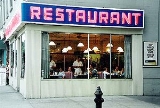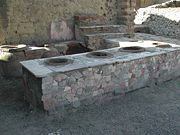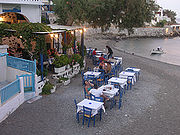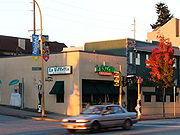
Restaurant
Encyclopedia

Food
Food is any substance consumed to provide nutritional support for the body. It is usually of plant or animal origin, and contains essential nutrients, such as carbohydrates, fats, proteins, vitamins, or minerals...
and drink
Drink
A drink, or beverage, is a liquid which is specifically prepared for human consumption. In addition to fulfilling a basic human need, beverages form part of the culture of human society.-Water:...
to customer
Customer
A customer is usually used to refer to a current or potential buyer or user of the products of an individual or organization, called the supplier, seller, or vendor. This is typically through purchasing or renting goods or services...
s in return for money. Meals are generally served and eaten on premises, but many restaurants also offer take-out
Take-out
Take-out or takeout , carry-out , take-away , parcel , or tapau , is food purchased at a...
and food delivery services
Delivery (commerce)
Delivery is the process of transporting goods. Most goods are delivered through a transportation network. Cargo are primarily delivered via roads and railroads on land, shipping lanes on the sea and airline networks in the air...
. Restaurants vary greatly in appearance and offerings, including a wide variety of the main chef's cuisine
Cuisine
Cuisine is a characteristic style of cooking practices and traditions, often associated with a specific culture. Cuisines are often named after the geographic areas or regions that they originate from...
s and service
Customer service
Customer service is the provision of service to customers before, during and after a purchase.According to Turban et al. , “Customer service is a series of activities designed to enhance the level of customer satisfaction – that is, the feeling that a product or service has met the customer...
models.
While inn
INN
InterNetNews is a Usenet news server package, originally released by Rich Salz in 1991, and presented at the Summer 1992 USENIX conference in San Antonio, Texas...
s and tavern
Tavern
A tavern is a place of business where people gather to drink alcoholic beverages and be served food, and in some cases, where travelers receive lodging....
s were known from antiquity
Ancient history
Ancient history is the study of the written past from the beginning of recorded human history to the Early Middle Ages. The span of recorded history is roughly 5,000 years, with Cuneiform script, the oldest discovered form of coherent writing, from the protoliterate period around the 30th century BC...
, these were establishments aimed at travelers, and in general locals would rarely eat there. Modern restaurants are dedicated to the serving of food, where specific dishes are ordered by guests and are prepared to their request. The modern restaurant originated in 18th century France
France
The French Republic , The French Republic , The French Republic , (commonly known as France , is a unitary semi-presidential republic in Western Europe with several overseas territories and islands located on other continents and in the Indian, Pacific, and Atlantic oceans. Metropolitan France...
, although precursors can be traced back to Roman
Ancient Rome
Ancient Rome was a thriving civilization that grew on the Italian Peninsula as early as the 8th century BC. Located along the Mediterranean Sea and centered on the city of Rome, it expanded to one of the largest empires in the ancient world....
times.
A restaurant owner is called a restaurateur (icon); both words derive from the French verb restaurer, meaning "to restore". Professional artisans of cooking are called chefs, while preparation staff and line cooks prepare food items in a more systematic and less artistic fashion.
History

Ancient Rome
Ancient Rome was a thriving civilization that grew on the Italian Peninsula as early as the 8th century BC. Located along the Mediterranean Sea and centered on the city of Rome, it expanded to one of the largest empires in the ancient world....
, thermopolia
Thermopolium
In ancient Rome, a thermopolium was a commercial establishment where it was possible to purchase ready-to-eat food. The forerunner of today's restaurant, the items served at the thermopolia are sometimes compared to modern fast-food...
(singular thermopolium) were small restaurant-bars which offered food and drinks to the customer. A typical thermopolium had L-shaped counters into which large storage vessels were sunk, which would contain either hot or cold food. They are linked to the absence of kitchens in many dwellings and the ease with which people could purchase prepared foods. Besides, eating out was also considered an important aspect of socialising.
In Pompeii
Pompeii
The city of Pompeii is a partially buried Roman town-city near modern Naples in the Italian region of Campania, in the territory of the comune of Pompei. Along with Herculaneum, Pompeii was destroyed and completely buried during a long catastrophic eruption of the volcano Mount Vesuvius spanning...
, 158 thermopolia with a service counter have been identified across the whole town area. They were concentrated along the main axes of the town and the public spaces where they were frequented by the locals.
Food catering establishments which may be described as restaurants were known since the 11th century in Kaifeng
Kaifeng
Kaifeng , known previously by several names , is a prefecture-level city in east-central Henan province, Central China. Nearly 5 million people live in the metropolitan area...
, China's
History of China
Chinese civilization originated in various regional centers along both the Yellow River and the Yangtze River valleys in the Neolithic era, but the Yellow River is said to be the Cradle of Chinese Civilization. With thousands of years of continuous history, China is one of the world's oldest...
northern capital during the first half of the Song Dynasty
Song Dynasty
The Song Dynasty was a ruling dynasty in China between 960 and 1279; it succeeded the Five Dynasties and Ten Kingdoms Period, and was followed by the Yuan Dynasty. It was the first government in world history to issue banknotes or paper money, and the first Chinese government to establish a...
(960–1279). With a population of over 1,000,000 people, a culture of hospitality and a paper currency, Kaifeng was ripe for the development of restaurants. Probably growing out of the tea houses and taverns that catered to travellers, Kaifeng's restaurants blossomed into an industry catering to locals as well as people from other regions of China. Stephen H. West argues that there is a direct correlation between the growth of the restaurant businesses and institutions of theatrical stage drama, gambling and prostitution which served the burgeoning merchant middle class
Four occupations
The four occupations or "four categories of the people" was a hierarchic social class structure developed in ancient China by either Confucian or Legalist scholars as far back as the late Zhou Dynasty and is considered a central part of the Fengjian social structure...
during the Song Dynasty.
Restaurants catered to different styles of cuisine, price brackets, and religious requirements. Even within a single restaurant much choice was available, and people ordered the entree they wanted from written menu
Menu
In a restaurant, a menu is a presentation of food and beverage offerings. A menu may be a la carte – which guests use to choose from a list of options – or table d'hôte, in which case a pre-established sequence of courses is served....
s. An account from 1275 writes of Hangzhou
Hangzhou
Hangzhou , formerly transliterated as Hangchow, is the capital and largest city of Zhejiang Province in Eastern China. Governed as a sub-provincial city, and as of 2010, its entire administrative division or prefecture had a registered population of 8.7 million people...
, the capital city for the last half of the dynasty:
- "The people of Hangzhou are very difficult to please. Hundreds of orders are given on all sides: this person wants something hot, another something cold, a third something tepid, a fourth something chilled; one wants cooked food, another raw, another chooses roast, another grill".
The restaurants in Hangzhou also catered to many northern Chinese who had fled south from Kaifeng during the Jurchen
Jurchens
The Jurchens were a Tungusic people who inhabited the region of Manchuria until the 17th century, when they adopted the name Manchu...
invasion of the 1120s, while it is also known that many restaurants were run by families formerly from Kaifeng.
Types of restaurants

Semi-casual
Semi-casual is a dress code in the American context. It is less presentational than Informal but not as loose, and potentially sexually suggestive, as full casual dress.Semi-casual dress may include:...
, semi-formal
Semi-formal
In Western clothing semi-formal is a grouping of dress codes, indicating the sort of clothes worn to events with a level of protocol between informal and formal...
, or formal wear
Formal wear
Formal wear and formal dress are the general terms for clothing suitable for formal social events, such as a wedding, formal garden party or dinner, débutante cotillion, dance, or race...
.
Typically, customers sit at tables, their orders are taken by a waiter
Waiter
Waiting staff, wait staff, or waitstaff are those who work at a restaurant or a bar attending customers — supplying them with food and drink as requested. Traditionally, a male waiting tables is called a "waiter" and a female a "waitress" with the gender-neutral version being a "server"...
, who brings the food when it is ready, and the customers pay the bill before leaving. In finer restaurants there will be a host or hostess or even a maître d'hôtel
Maître d'hôtel
The maître d’hôtel in the original French language is literally the "master of the hotel". In a suitably staffed restaurant or hotel, it is the person in charge of assigning customers to tables and dividing the dining area into areas of responsibility for the various servers on duty. The plural...
to welcome customers and to seat them. Other staff waiting on customers include busboy
Busboy
Busser, busboy and busgirl are terms used in the United States for someone who works in the restaurant and catering industry clearing tables, taking dirty dishes to the dishwasher, setting tables and otherwise assisting the waiting staff....
s and sommelier
Sommelier
A sommelier , or wine steward, is a trained and knowledgeable wine professional, commonly working in fine restaurants, who specializes in all aspects of wine service as well as wine and food matching...
s.
Restaurants often specialize in certain types of food or present a certain unifying, and often entertaining, theme
Theme restaurant
Theme restaurants are restaurants in which the concept of the restaurant takes priority over everything else, influencing the architecture, food, music, and overall 'feel' of the restaurant...
. For example, there are seafood
Seafood
Seafood is any form of marine life regarded as food by humans. Seafoods include fish, molluscs , crustaceans , echinoderms . Edible sea plants, such as some seaweeds and microalgae, are also seafood, and are widely eaten around the world, especially in Asia...
restaurants, vegetarian restaurants or ethnic restaurants. Generally speaking, restaurants selling food characteristic of the local culture are simply called restaurants, while restaurants selling food of foreign cultural origin are called ethnic restaurants.
For some time the travelling public has been catered for with ship's mess
Mess
A mess is the place where military personnel socialise, eat, and live. In some societies this military usage has extended to other disciplined services eateries such as civilian fire fighting and police forces. The root of mess is the Old French mes, "portion of food" A mess (also called a...
es and railway restaurant cars which are, in effect, travelling restaurants. (Many railways, the world over, also cater for the needs of travellers by providing Raiway Refreshment Rooms [a form of restaurant] at railway stations.) In recent times there has been a trend to create a number of travelling restaurants, specifically designed for tourists. These can be found on such diverse places as trams, boats, buses, etc.
Restaurant regulations
Depending on local customs and the establishment, restaurants may or may not serve alcoholAlcoholic beverage
An alcoholic beverage is a drink containing ethanol, commonly known as alcohol. Alcoholic beverages are divided into three general classes: beers, wines, and spirits. They are legally consumed in most countries, and over 100 countries have laws regulating their production, sale, and consumption...
. Restaurants are often prohibited from selling alcohol
Ethanol
Ethanol, also called ethyl alcohol, pure alcohol, grain alcohol, or drinking alcohol, is a volatile, flammable, colorless liquid. It is a psychoactive drug and one of the oldest recreational drugs. Best known as the type of alcohol found in alcoholic beverages, it is also used in thermometers, as a...
without a meal by alcohol sale laws; such sale is considered to be activity for bars
Bar (establishment)
A bar is a business establishment that serves alcoholic drinks — beer, wine, liquor, and cocktails — for consumption on the premises.Bars provide stools or chairs that are placed at tables or counters for their patrons. Some bars have entertainment on a stage, such as a live band, comedians, go-go...
, which are meant to have more severe restrictions. Some restaurants are licensed to serve alcohol ("fully licensed"), and/or permit customers to "bring your own" alcohol (BYO / BYOB
BYOB
BYOB is an acronym most commonly meant to stand for "bring your own bottle", "bring your own booze" "bring your own bucket" or "bring your own beer"....
). In some places restaurant licenses may restrict service to beer, or wine and beer.
Restaurant guides

Restaurant guides review restaurants, often ranking them or providing information for consumer decisions (type of food, handicap
Disability
A disability may be physical, cognitive, mental, sensory, emotional, developmental or some combination of these.Many people would rather be referred to as a person with a disability instead of handicapped...
accessibility, facilities, etc.). One of the most famous contemporary guides, in Western Europe
Western Europe
Western Europe is a loose term for the collection of countries in the western most region of the European continents, though this definition is context-dependent and carries cultural and political connotations. One definition describes Western Europe as a geographic entity—the region lying in the...
, is the Michelin
Michelin Guide
The Michelin Guide is a series of annual guide books published by Michelin for over a dozen countries. The term normally refers to the Michelin Red Guide, the oldest and best-known European hotel and restaurant guide, which awards the Michelin stars...
series of guides which accord from 1 to 3 stars
Star (classification)
Stars are often used as symbols for classification purposes. They are used by reviewers for ranking things such as movies, TV shows, restaurants, and hotels. For example, one to five stars is commonly employed to categorize hotels.-Restaurant ratings:...
to restaurants they perceive to be of high culinary merit. Restaurants with stars in the Michelin guide are formal, expensive establishments; in general the more stars awarded, the higher the prices.
The main competitor to the Michelin guide in Europe is the guidebook series published by Gault Millau
Gault Millau
Gault et Millau is one of the most influential French restaurant guides founded by two restaurant critics, Henri Gault and Christian Millau in 1965. Gault Millau is most famous for its rating system, on a scale of 1 to 20. Restaurants below 10 points are almost never listed...
. Unlike the Michelin guide which takes the restaurant décor and service into consideration with its rating, Gault Millau only judges the quality of the food. Its ratings are on a scale of 1 to 20, with 20 being the highest.
In the United States, the Forbes Travel Guide (previously the Mobil travel guides) and the AAA
American Automobile Association
AAA , formerly known as the American Automobile Association, is a federation of 51 independently operated motor clubs throughout North America. AAA is a not-for-profit member service organization with more than 51 million members. AAA provides services to its members such as travel, automotive,...
rate restaurants on a similar 1 to 5 star (Forbes) or diamond (AAA) scale. Three, four, and five star/diamond ratings are roughly equivalent to the Michelin one, two, and three star ratings while one and two star ratings typically indicate more casual places to eat. In 2005, Michelin released a New York City
New York City
New York is the most populous city in the United States and the center of the New York Metropolitan Area, one of the most populous metropolitan areas in the world. New York exerts a significant impact upon global commerce, finance, media, art, fashion, research, technology, education, and...
guide, its first for the United States. The popular Zagat Survey
Zagat Survey
Zagat Survey was established by Tim and Nina Zagat in 1979 as a way to collect and correlate the ratings of restaurants by diners. For their first guide, covering New York City, the Zagats surveyed their friends. As of 2005, the Zagat Survey included 70 cities, with reviews based on the input of...
compiles individuals' comments about restaurants but does not pass an "official" critical assessment. In the United States Gault Millau is published as the Gayot guide, after founder Andre Gayot
André Gayot
André Gayot is a French restaurant critic. With his friends Gault and Millau, he coined and promoted the term "Nouvelle Cuisine" in the early 1970s. In 1981 he began publishing a series of guidebooks known as Gayot Guides, where restaurants are rated on a 20-point scale, based on the system of...
. Its restaurant ratings use the same 20 point system, and are all published online.
The Good Food Guide, published by the Fairfax Newspaper Group in Australia, is the Australian guide listing the best places to eat. Chefs Hats are awarded for outstanding restaurants and range from one hat through three hats. The Good Food Guide also incorporates guides to bars, cafes and providers. The Good Restaurant Guide is another Australian restaurant guide that has reviews on the restaurants as experienced by the public and provides information on locations and contact details. Any member of the public can submit a review.
Nearly all major American newspaper
Newspaper
A newspaper is a scheduled publication containing news of current events, informative articles, diverse features and advertising. It usually is printed on relatively inexpensive, low-grade paper such as newsprint. By 2007, there were 6580 daily newspapers in the world selling 395 million copies a...
s employ food critic
Food critic
The terms food critic, food writer, and restaurant critic can all be used to describe a writer who analyzes food or restaurants and then publishes the results of their findings. While these terms are not strictly synonymous they are often used interchangeably, at least in some circumstances...
s and publish online dining guides for the cities they serve. A few papers maintain a reputation for thorough and thoughtful review of restaurants to the standard of the good published guides, but others provide more of a listings service.
More recently Internet sites have started up that publish both food critic reviews and popular reviews by the general public. Their major competition comes from blog
Blog
A blog is a type of website or part of a website supposed to be updated with new content from time to time. Blogs are usually maintained by an individual with regular entries of commentary, descriptions of events, or other material such as graphics or video. Entries are commonly displayed in...
gers, particularly publishers of food blogs, also called foodie
Foodie
Foodie is an informal term for a particular class of aficionado of food and drink. The word was coined in 1981 by Paul Levy and Ann Barr, who used it in the title of their 1984 book The Official Foodie Handbook.- Distinguished from gourmet :...
s. These writers and publishers represent the common dining aficionado rather than the gourmet, and thus do not provide "official" reviews, but nonetheless are capable of garnering large, loyal followings.
Economics

United States
As of 2006, there are approximately 215,000 full-service restaurants in the United States, accounting for $298 billion, and approximately 250,000 limited-service (fast food) restaurants, accounting for $260 billion.One study of new restaurants in Cleveland, Ohio found that 1 in 4 changed ownership or went out of business after one year, and 6 out of 10 did so after three years. (Not all changes in ownership are indicative of financial failure.) The three-year failure rate for franchises was nearly the same.
Canada
There are 86,915 commercial foodservice units in Canada, or 26.4 units per 10,000 Canadians. By segment, there are:- 38,797 full-service restaurants
- 34,629 limited-service restaurants
- 741 contract and social caterers
- 6,749 drinking places
Fully 63% of restaurants in Canada are independent brands. Chain restaurants account for the remaining 37%, and many of these are locally owned and operated franchises.
See also
- Culinary arts
- FoodserviceFoodserviceFood Service or catering industry defines those businesses, institutions, and companies responsible for any meal prepared outside the home...
- Food streetFood streetA food street is a street that is devoted specifically to eating out. They are lined with food stalls, restaurants, and other food shops, and are typically pedestrianized.- Pakistan :...
- Food safetyFood safetyFood safety is a scientific discipline describing handling, preparation, and storage of food in ways that prevent foodborne illness. This includes a number of routines that should be followed to avoid potentially severe health hazards....
- Food qualityFood qualityFood quality is the quality characteristics of food that is acceptable to consumers. This includes external factors as appearance , texture, and flavour; factors such as federal grade standards and internal .Food quality in the United States is enforced by the Food Safety Act 1990...
- Menu engineeringMenu engineeringMenu engineering is an interdisciplinary field of study devoted to the deliberate and strategic construction of menus. It is also commonly referred to as Menu Psychology.- Definition :...
- Health food restaurantHealth food restaurantHealth food restaurants have been around for decades serving nutritional food to the public. Health food is defined by Dictionary.com as any natural food popularly believed to promote or sustain good health, as by containing vital nutrients, being grown without the use of pesticides, or having a...

